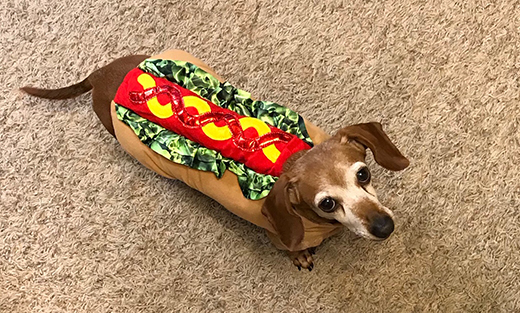Halloween no treat for pets, says Kansas State University veterinarian
Monday, Oct. 29, 2018

If you dress your pet up for Halloween, Kansas State University veterinarian Susan Nelson says try it on the animal ahead of time so it will get used to it. Nelson also recommends costumes that don't restrict the pet's vision, hearing, breathing and smelling abilities.
MANHATTAN — Halloween can be fun for children and adults alike, but for pets it can be a potentially dangerous holiday, according to a Kansas State University veterinarian.
Susan Nelson, clinical professor at the university's Veterinary Health Center, provides some tips to keep your furry friend safe during the fun and spooky holiday.
Nelson said one of the most important things to do is to keep all candy — whether for trick-or-treaters or yourself — where pets can't get to it.
"Chocolates, sugar-free candies and gums, raisins and some nuts can be toxic to pets," Nelson said. "Candy wrappers and lollipop sticks can also become choking hazards or gastrointestinal foreign bodies if ingested."
Pets can look adorable in costumes, so if you are planning on dressing one up, try the costume on your pet in advance to give it time to get used to it, Nelson said. Also, ensure that the pet can see, hear, smell and breathe when in costume. Make sure to avoid costumes that have any loose or small parts that can be pulled off and ingested.
"If your pet seems distressed, allergic or shows abnormal behavior with a costume, consider having it wear a Halloween-themed bandana instead," Nelson said.
Strange visitors in scary costumes and loud noises may cause even the most social and/or calm animal to be frightened and react negatively. Nelson said that if your pet is one that becomes anxious because of noise and activity, keep it kenneled away from the activity or make a comfy spot in a back room with the radio or TV turned on to help drown out noise caused by ringing doorbells and excited children. This will help ensure that the animal doesn’t bolt out the door and run off when frightened by a scary costume.
"Because many pets can become distressed by the frequent ringing of the doorbell, consider disconnecting the bell for the night and using a motion detector to detect visitors instead," Nelson said. "Alternatively, you can wait at the end of the driveway to greet the kids and hand out candy outside the house, weather permitting."
As Halloween is one of the holidays where pets are more likely to run off and become lost, Nelson said to make sure your pet has proper forms of identification, such as a microchip or tags. A reflective collar may also help others to spot your pet should it go missing at night.
Another tip from Nelson is to be mindful that your pet may be frightened by one of its own familiar family members when that person is disguised in a costume.
"A severe fright can make the pet wary of that person for some time to come, even after the costume has been removed," Nelson said. "Get your pet used to the costume well in advance of the holiday by giving it treats while wearing part of the costume, and then later, all of the costume as the pet becomes more familiar with it."
Cats, especially black ones, are often sought after with cruel intentions during Halloween, Nelson said, and caution needs to be exercised during this time to keep them safe. She said many shelters will not adopt out black cats a few weeks before and after Halloween.
Nelson said to also be aware of these other possible Halloween hazards for your pet:
• Keep pets away from electrical cords and decorations. Chewing on electrical cords can lead to life-threatening electrocution and burns. Decorations using corncobs, strings or tassels can be ingested and cause obstructions in the gastrointestinal tract.
• Keep lit pumpkins and candles out of reach, as they can burn your pet. A frightened or curious pet also can tip over a candle, which could lead to a house fire.
• While not poisonous, glow sticks have a very bitter taste and can cause irritation to the mouth. Pets, especially cats, may drool uncontrollably and become very agitated. Some of the larger glow sticks contain a small glass vial, which when broken, activates the glow stick. The glass can be harmful if ingested.
If you suspect your pet has ingested something toxic, Nelson said to call your veterinarian, the ASPCA Poison Control Center at 888-426-4435 or the Pet Poison Helpline at 800-213-6680 immediately for advice.
For more information, contact the Veterinary Health Center at 785-532-5690.
